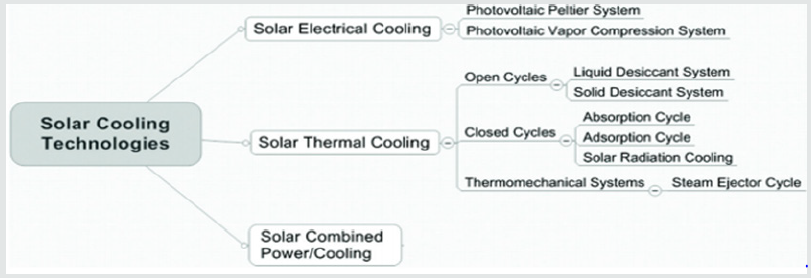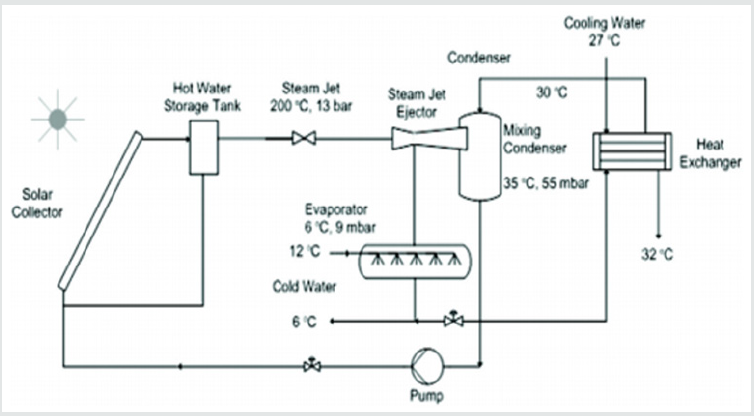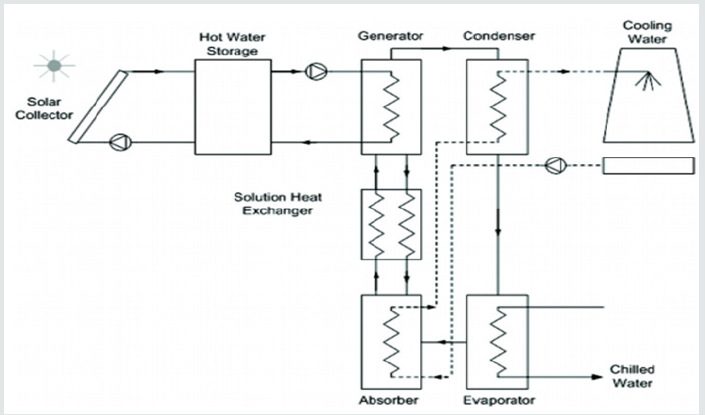
Lupine Publishers Group
Lupine Publishers
Menu
ISSN: 2641-6794
Review Article2641-6794 
Implication of Climate Change on Human Health in Sub- Saharan Africa Volume 4 - Issue 4
Jani DB*
- Department of Mechanical Engineering, Gujarat Technological University, India
Received: February 17, 2020; Published: March 04, 2020
Corresponding author: D.B. Jani, Department of Mechanical Engineering, Gujarat Technological University, India
DOI: 10.32474/OAJESS.2020.04.000195
Abstract
The present review summarized the application of renewable solar energy in various cooling techniques to produce thermal comfort of the built environment. Solar assisted cooling is the newer sustainable cooling technology which can be used to develop thermally stable built environment within residential and commercial buildings. Furthermore, the same is environment friendly and energy efficient. It is stronger tool to fight the devil of global warming. It may also be used for air conditioning in medical emergency in remote areas where the electricity supply is not available. There is an ameliorated interest in the progressive development and elaborated use of solar assisted cooling technologies due to their various economic and impressive environmental benefits, enabling freely available renewable solar energy to be used for applications such as district cooling system networks. Compared to traditional systems this creates new possibilities for utilizing low temperature based naturally available free energy..
Keywords: Desiccant cooling; Green energy; Renewable solar heat; Sustainable cooling energy
Abbreviations: CFC: Chloro Fluro Carbon; CPC: Concentrating Plate Solar Collectors; COP: Coefficient of Performance; DCS: Desiccant Cooling System; DESRAD: Desiccant Enhanced Nocturnal Radiation; VCS: Vapour Compression System; PVC: Photovoltaic Solar Collectors; TE: Thermo-electric systems
Introduction
Sincere efforts are required in the energy production sector
to save the planate earth against global warming phenomenon by
rapid growth of renewable solar energy. Global warming mainly
responsible for the release of CO2 from fossil fuel based thermal
power plant. Worldwide strict environmental policy should be
implemented to minimize the use of CFC based air conditioning
system to protect the ozone layer. Day by day world overall energy
consumption have been increased exponentially. So, it is high
time to minimize the production of greenhouse gases for energy
sector by use of sustainable solar energy. Maintaining thermally
comfort environment in building indoor space is responsible for
around 56% of overall building energy consumption. This figure
may increase in hot and humid environment. Moreover, the life
of fossil fuels is limited to regular supply across the world as oil
remains the primary energy source. So, it is high time to reconsider
the renewable energy sources as regular energy supply sources
to dampen the global temperature rise due to global warming.
Public awareness should be increased to develop more and more
application of this solar energy sources like as solar roof top energy
supply system and renewable solar based sustainable cooling
technologies. This energy supply is independent of the petroleumbased
fossil energy sources to provide major part of primary
energy supply for various building heating and cooling applications
to make sustainable built environment. Solar energy resources are
mainly available at cheaper rate due to its free availability during
most of the sunny days round the year in most part of the world.
The solar cooling availability is in-line with the peak demand
of cooling at the time of hot summer when the intensity of solar
radiations is also found very high. Various types of solar cooling
technology in the different applications as shown in Figure 1 can
substantially dampen the environmental impact and the energy
consumption issues demanded mostly by conventional vapor
compression based traditional air-conditioning systems. Therefore,
the purpose of the review is to provide an overview of the renewable
solar energy based comfort cooling technologies that utilize
freely available solar radiations to supply the primary energy and
introduce their prospects as environmentally sustainable solar
powered cooling technologies as compared to traditional cooling
[1-3].
Solar Thermal Cooling
In solar powered cooling thermal energy produced by solar
heat receiving by use of different solar collectors is utilized for
cooling the indoor building space. Solar radiations received from
sun are converted into electricity by chemical process occurs in
various PV modules. This solar-thermal energy conversion process
can be categorized into open sorption cycles, closed sorption cycles,
and thermo-mechanical systems [4].
The solid or liquid desiccant assisted sorption cooling systems
that are used for either dehumidification or humidification by use
of moisture control and cooling the humid air especially in hot and
humid climate. Mainly, desiccant systems dehumidify the moist air
by travel from one airstream to another by using two fundamental
sorption principles. The former convey moisture from process to
regeneration air stream due to the deviation in vapor pressure
among the two. i.e. moisture laden humid air and dry desiccant
matrix of the rotary dehumidifier. Moisture from humid air transfers
to the surface of desiccant material by the process of adsorption
between two air streams. The exited dry and heated air is further
processed to the cooling in heat exchanger. The rotary dehumidifier
needs periodically reactivating the same by passing the hot air
in regeneration section of the same to make the dehumidifier
working for the next cycle as shown in Figure 2. To provide the heat
for the regeneration of the dehumidifier can be utilized by use of
renewable solar energy. This can be explained in detail in the Figure
3. The silica gel is commonly used solid desiccant while the CaCl2 is
commonly used liquid desiccant material in the cycle [5].
The solid desiccants adsorb the moisture at its surface without any further chemical reaction. However, liquid desiccant materials remove water vapor form the moist air by undergoing a chemical or physical change during absorption of the same [6]. There are different ways to provide regeneration energy for the desiccant reactivation. Solar thermal energy can save the highgrade electricity for reactivating the desiccant materials having temperature in the range 50-70 °C. Different types of solar collectors available in the market having their efficiency between 30-65%. The coefficient of performance (COP) obtained by this solar powered desiccant cooling cycle is in the range 05-1.8 based on primary energy supply. The performance of the solar powered hybrid cooling system can be ameliorated further if the humidity is increased further in the tropical climate [7]. The absorption cycle explained by the schematic layout in Figure 4 shows to be used as the absorption refrigeration cycle. In which compressor used in the conventional vapor compression (VC) cycle can be replaced with the absorber-regenerator assembly in the cycle. In the absorber, the absorbent-rich solution is mixed with the refrigerant in some fixed proportion according to cooling requirement. During this process, the absorber pressure gets reduced by removing the absorption heat to the outdoor environment. Then the solution pump adjusts the high-pressure requirement according to mixture strength. The heat necessary for the regenerating the solution can be provided from solar thermal energy. The rest of function of condenser is same as the conventional cooler. Some commonly used absorber and refrigerant pair are as water and lithium bromide as well as ammonia and water. This absorption system can be generally suited to large capacity for cooling and refrigeration requirement [8].
The working of water and lithium bromide can be limited by
the early freezing point temperature of water. This can be extended
further by use of ammonia and water absorption system by using
water as absorber and ammonia as refrigerant used in the system.
The toxic nature of ammonia needs special precautions against
leakage in the system [9-11]. The solar collectors mainly used in
solar powered cooling technologies can be categorized as following:
• flat plate solar thermal collectors;
• evacuated tubes air and water thermal collectors;
• stationary solar thermal collectors;
• non-imaging concentrating collectors such as CPC;
• dish type concentrating solar thermal collectors;
• linear focusing type solar thermal concentrators;
• solar ponds;
• photovoltaic (PV) systems; and
• thermoelectric (TE) systems.
The solar assisted adsorption refrigeration system is the
most promising alternative cooling technology because it is ecofriendly
with cheaper in first cost, ameliorated efficiency, easy to
manufacture and minimum maintenance requirements [12-16].
The steam ejector cooling cycle depicted in Figure 5 is type of
the thermo-mechanical cooling system. It shows that the steam
ejector cycle coupled to parabolic type solar thermal collector.
The steam generated by high temperature developed by the
solar collector is first passing through the steam ejector. During
this process, the evaporator pressure is lowered due to pressure
difference, and water is evaporated in the evaporator by absorbing
the heat from the cold water. When cooling is not required, the
auxiliary connected steam turbines with the cooler can be used to
produce electricity. Most of the steam ejector cycle requires steam
at pressures in the range of 0.11-1.2 MPa, and temperatures in the
range of 122 °C-185 °C. The rest of the whole cycle is working at
normal atmospheric pressure [17-20].
Comparison between different solar cooling cycles
The coefficient of performance based on the primary energy (thermal) supply can be compared for the different types of solar thermal cooling techniques has been tabulated in Table 1. It is seen that the single-effect absorption systems had a thermal coefficient of performance obtained between range of value 0.502-0.731, while in the case of the adsorption systems, thermal coefficient of performance obtained is comparatively lower around 0.591, similarly, in case of liquid desiccant based thermal cooling system having thermal coefficient of performance slightly higher for solar heat supply as 0.742, while in case of the solid desiccant assisted cooling thermal coefficient of performance based on solar heat for the regeneration of desiccant is obtained around 0.512, and a steam jet thermal cooling the value of thermal coefficient of performance has obtained maximum among the all above discussed cased is 0.85. The range of operating temperature in solar thermal cooling is different for different configurations as absorption systems working in the range of 62 °C-164 °C, while adsorption systems working at comparatively lower temperature range of 54 °C- 85 °C, similarly, a liquid desiccant based solar thermal cooling temperature obtained as 68 °C, and a steam jet system working at temperature comparatively higher as 118 °C. For most of these systems operated below 105 °C, the flat-plate solar thermal collectors can obtain this limit temperature, similarly in case of the concentrating type solar thermal collectors obtained comparatively temperature higher than 105 °C. The annual thermal coefficient, can be given as ratio between the annual cooling capacity and the annual solar thermal energy input, can be given by kW-hour. It is found that the lithium bromide water absorption cooling is having highest annual performance, while the adsorption thermal cooling found poor annual performance. Based on above result is seen that the 72% of the all cooling systems employed an absorption cycle due to its better performance [21-22].
Desiccant assisted cooling and air conditioning system is
the future technology for the large cooling requirement by the
industries to condition large area because of applicability of
renewable solar energy for regeneration heat supply for its
economy operation. So that is environmentally viable and eliminate
the use of CFCs based refrigerants which are responsible for ozone
layer depletion. Moreover, it may possible to make use of industrial
waste heat of process and power plant industries. Thus, it lowers
peak electricity demand. Also, this innovative cooling technology
can make use of the renewable solar thermal heat energy for its
working and minimize the use of high-grade electricity. This will
minimize the emission of CO2 in environment by the thermal power
plant which is mainly responsible for the global warming [23].
Current investigations on advances in solar powered desiccant
cooling systems aims to research on hybrid desiccant materials
that are regenerate at nearly ambient temperature conditions so
that the use of solar heat or industrial waste heat can be effectively
used. Due to its eco-friendly and greater operational economy
desiccant cooling can be emerged as potential alternatives to the
vapor compression based traditional air conditioners in the coming
days. Moreover, the use of the desiccant cooling can ameliorate the
indoor air quality, solar solid desiccants and liquid desiccants are
still under research as to find out most efficient and effective way
of their regeneration heat supply. The recent concept of hybrid
cooling in which a desiccant bed integrated in the roof along with
a traditional vapor compression-based cooling system to achieve
both latent and sensible cooling in hot and humid climates in the
tropical regions called a desiccant enhanced nocturnal radiation
(DESRAD). By use of this innovative cooling concept, the sensible
cooling is obtained during the night and the desiccant is reactivated
effectively during daytime by application of freely available
renewable solar energy.
The operation of this hybrid cooling can be carried out in two
operating modes: adsorption mode during nighttime; while the
other is daytime desorption mode. During the cooled nighttime,
comparatively cooled air is circulated by passing through desiccant
material laden bed provided on the roof where the water vapor
from humid air eliminated to make it dry. The heat of sorption
is transferred to the outside colder ambient during nighttime.
After the dry and comparatively warm dehumidified air coming
out of the desiccant material laden large bed area, it passes over
an evaporative cooler post cooling of desorbed air before supply
to the conditioned indoor space. While circulating through room,
it absorbs both the heat and moisture from the space while
maintaining the indoor conditioning of room. The process of
attracting and holding evaporate room depending on proportion
of water vapor as per latent heat load of the room or humidity
level. For the regeneration of desiccant bed use of solar energy
is the prominent option. Thus, integration of desiccant cooling
with the traditional vapor compression-based cooling results
into hybrid system which saves more than 46% of cooling power
and substantially lowers its operating cost. Thus, solar powered
thermal cooling is the key to ameliorate the cost energy savings
in cooling the building. This way of sustainable cooling is the new
way for future research and demonstration projects in field of built
environment [24-25].
Conclusion
Energy dependency of indoor thermally cooling system can be reduced to the great extent by use of renewable solar energy in various cooling and air-conditioning applications in residential and industrial sector. Exponential rise in building cooling demand is associated mainly with the recent climate change and is projected to increase further in the coming future due to globally changing environmental condition; the cooling technologies based on solar energy are promising alternatives for the future cooling and airconditioning applications. Through this review of the available solar powered renewable space cooling systems, their performance potential and their advancement have been reviewed in detail. Moreover, the further research and investigations on the use of advanced solar collectors to achieve still better solar collecting efficiency and generation temperature can be seen as the most important topic in additional investigations in near future in the field of renewable solar cooling technologies in maintaining sustainable built environment.
References
- Jani DB, Mishra M, Sahoo PK (2015) Performance studies of hybrid solid desiccant - vapor compression air-conditioning system for hot and humid climates. Energy and Buildings 102: 284-292.
- Vyas VD, Jani DB (2016) An overview on application of solar thermal power generation. International Journal of Engineering Research and Allied Sciences 1: 17-21.
- Jani DB, Mishra M, Sahoo PK (2016) Performance analysis of hybrid solid desiccant - vapor compression air-conditioning system in hot and humid weather of India. Building Services Engineering Research and Technology 37(5): 523-538.
- Jani DB, Mishra M, Sahoo PK (2016) Solid desiccant air conditioning - A state of the art review. Renewable and Sustainable Energy Reviews 60: 1451-1469.
- Jani DB, Mishra M, Sahoo PK (2016) Experimental investigation on solid desiccant - vapor compression hybrid air- conditioning system in hot and humid weather. Applied Thermal Engineering 104(5): 556-564.
- Jani DB, Mishra M, Sahoo PK (2017) A critical review on solid desiccant-based hybrid cooling systems. International Journal of Air-conditioning and Refrigeration 25(3): 1-10.
- Jani DB, Shah N, Panchal N (2018) A review on application of desiccant dehumidification - vapor compression hybrid cooling system in hot-humid climates. International Journal of Innovative and Emerging Research in Engineering 5(2): 1-5.
- Jani DB, Lalkiya D, Patel S (2018) A critical review on evaporative desiccant cooling. International Journal of Innovative and Emerging Research in Engineering 5(1): 24-29.
- Jani DB, Mishra M, Sahoo PK (2018) A critical review on application of solar energy as renewable regeneration heat source in solid desiccant - vapor compression hybrid cooling system. Journal of Building Engineering 18: 107-124.
- Jani DB, Mishra M, Sahoo PK (2018) Investigations on effect of operational conditions on performance of solid desiccant-based hybrid cooling system in hot and humid climate. Thermal Science and Engineering Progress 7: 76-86.
- Kiran, Bhabhor, Jani DB, Dabhi RJ, Thakur DH (2018) Recent applications of renewable solar energy in desiccant cooling systems - A review. National Conference on Recent Trends in Renewable Energy Application & Research, The Institution of Engineers (India), Gujarat State Centre, Ahmedabad, February 16(17): 1-5.
- Jani DB, Shah N, Panchal N (2018) Solar assisted solid desiccant - vapor compression hybrid air-conditioning system. Applications of solar energy pp. 233-250.
- Jani DB (2019) Use of renewable solar energy in desiccant assisted cooling techniques. International Journal of Advanced Research and Review 4(6): 6-14.
- Fong KF, Lee CK (2020) Solar desiccant cooling system for hot and humid region- A new perspective and investigation. Solar Energy 195: 677-684.
- Dadi M, Jani DB (2019) Solar energy as a regeneration heat source in hybrid solid desiccant- vapor compression cooling system- A review. Journal of Emerging Technologies and Innovative Research 6(5): 421-425.
- Jani DB, Suthar M, Patel P, Shah J, Suthar A (2019) An overview on solar powered drinking water cooler. International Journal of Innovative Research in Technology 6(5): 77-81.
- Alghool DM, Elmekkwy YT, Haouari M, Elomri A (2020) Optimization of design and operation of solar assisted district cooling systems. Energy Conversion and Management 6: 100-128.
- Tashtoush B, Nayfeh Y (2020) Energy and economic analysis of a variable geometry ejector in solar cooling systems for residential buildings. Journal of Energy Storage 27: 101-161.
- Jani DB, Patel D, Parmar V, Chitle N, Raulji D (2019) An overview on solar powered evaporative water cooler with UV protection. International Journal of Innovative Research in Technology 6(4): 172-176.
- Palomba V, Wittstadt U, Bonanno A, Tanne M, Vasta S (2019) Components and design guidelines for solar cooling systems: The experience of ZEOSOL. Renewable Energy 141: 678-692.
- Jani DB (2019) Application of renewable solar energy in liquid desiccant powered dehumidification and cooling. Journal of Environment Protection and Sustainable Development 5: 1-6.
- Ayadi O, Al-Dahidi S (2019) Comparison of solar thermal and solar electric space heating and cooling systems for buildings in different climatic regions. Solar Energy 188: 545-560.
- Comino F, Gonzalez JC, Navas-Martos FJ, Adana MR (2020) Experimental energy performance assessment of solar desiccant cooling system in southern Europe climates. Applied Thermal Engineering 165: 114-128.
- Hu M, Zhao B, Ao X, Ren X, Pei G (2020) Performance assessment of tri-functional system integrating solar, PV, solar thermal, and radiative sky cooling. Applied Energy 260: 114-126.
- Pintaldi S, Li J, Sethuvenkatraman S, White S, Rosengarten G (2019) Model predictive control of a high solar thermal cooling system with thermal storage. Energy and Buildings 196: 214-226.

Top Editors
-

Mark E Smith
Bio chemistry
University of Texas Medical Branch, USA -

Lawrence A Presley
Department of Criminal Justice
Liberty University, USA -

Thomas W Miller
Department of Psychiatry
University of Kentucky, USA -

Gjumrakch Aliev
Department of Medicine
Gally International Biomedical Research & Consulting LLC, USA -

Christopher Bryant
Department of Urbanisation and Agricultural
Montreal university, USA -

Robert William Frare
Oral & Maxillofacial Pathology
New York University, USA -

Rudolph Modesto Navari
Gastroenterology and Hepatology
University of Alabama, UK -

Andrew Hague
Department of Medicine
Universities of Bradford, UK -

George Gregory Buttigieg
Maltese College of Obstetrics and Gynaecology, Europe -

Chen-Hsiung Yeh
Oncology
Circulogene Theranostics, England -
.png)
Emilio Bucio-Carrillo
Radiation Chemistry
National University of Mexico, USA -
.jpg)
Casey J Grenier
Analytical Chemistry
Wentworth Institute of Technology, USA -
Hany Atalah
Minimally Invasive Surgery
Mercer University school of Medicine, USA -

Abu-Hussein Muhamad
Pediatric Dentistry
University of Athens , Greece

The annual scholar awards from Lupine Publishers honor a selected number Read More...










